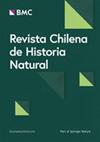蓬塔阿雷纳斯市的维管植物区系:成分、生命形式和生物地理起源的比较分析
IF 1.4
4区 环境科学与生态学
Q3 BIODIVERSITY CONSERVATION
引用次数: 0
摘要
对蓬塔阿雷纳斯市公共场所的维管植物区系组成进行了研究。研究人员对这些物种进行了鉴定,并将其记录在数据库中,同时还补充了有关分类学分类、生长习性、Raunkiaer 的生活形态、原产地状态(本地或外来)以及原始大陆分布的信息。这些数据与在智利中部其他五个城市进行的研究进行了比较,并利用辛普森指数的加法补码(1- βsim)分析了与这些城市的组成相似性。在蓬塔阿雷纳斯,共鉴定出 119 个物种,与智利中部城市相比,其表现出更高的裸子植物比例。代表种类最多的科是菊科(16 种)、豆科(14 种)、蔷薇科(14 种)、蒲葵科(12 种)和松科(10 种),共占植物丰富度的 55%。蓬塔阿雷纳斯与智利中部其他城市的植物组成相似度介于 0.187 至 0.315 之间,相似度低于偶然性(蒙特卡洛随机检验;P < 0.05)。蓬塔阿雷纳斯维管植物区系的主要原产地分布是欧洲,而智利中部城市则是亚洲。最后,外来物种的比例(91.6%)和外来物种与本地物种的比例(16:16)在智利城市中最高,也高于全球其他114个城市。这些结果表明,蓬塔阿雷纳斯的城市植物区系与智利中部城市的植物区系不同,不仅在分类组成上不同,而且在生长习性、生物地理起源和高度外来性方面也不同。这些差异可能是由于蓬塔阿雷纳斯与世隔绝,且地处极南位置(南纬 53°),从而形成了独特的城市植物区系结构。本文章由计算机程序翻译,如有差异,请以英文原文为准。
Vascular flora of Punta Arenas city: comparative analysis of composition, life forms, and biogeographic origins
The composition of the vascular flora in Punta Arenas city, found in the city’s public spaces, was studied. The species were identified and recorded in a database, which was supplemented with information on taxonomic classification, growth habit, Raunkiaer’s life form, origin status (native or exotic), and original continent-level distribution. These data were compared with studies conducted in five other cities in central Chile, together with an analysis of compositional similarity with these cities, by using the additive complement of Simpson’s index (1– βsim). In Punta Arenas, 119 species were identified, showing a higher proportion of Gymnosperms compared to central Chilean cities. The most represented families were Asteraceae (16 species), Fabaceae (14), Rosaceae (14), Poaceae (12), and Pinaceae (10), which together accounted for 55% of the floristic richness. The compositional similarity between Punta Arenas and the other central Chilean cities ranged from 0.187 to 0.315, showing lower similarity than expected by chance (Montecarlo randomization test; P < 0.05). The primary origin distribution of Punta Arenas’ vascular flora was European, unlike central Chilean cities where it was Asian. Finally, the proportion of exotic species (91.6%) and the number of exotic species per native species (16 exotics/native) were the highest documented for cities in Chile and higher than in other 114 cities worldwide. These results indicate that Punta Arenas’ urban flora differs from the flora in central Chilean cities, not only in taxonomic composition but also in growth habit, biogeographical origin, and high level of exoticism. These differences are likely due to the city’s territorial isolation and extreme southern location (53°S), leading to a unique urban flora configuration.
求助全文
通过发布文献求助,成功后即可免费获取论文全文。
去求助
来源期刊

Revista Chilena de Historia Natural
环境科学-生态学
CiteScore
2.50
自引率
18.20%
发文量
9
审稿时长
>36 weeks
期刊介绍:
Revista Chilena de Historia Natural (RCHN) publishes original research dealing with past and present phenomena from organismic to higher levels of biological organization, considering both empirical and theoretical studies on all kinds of taxa and environments.
The major areas covered by RCHN are: botany and zoology; physiological and behavioral ecology; population biology; community and ecosystem ecology; systematics, biogeography and evolution.
 求助内容:
求助内容: 应助结果提醒方式:
应助结果提醒方式:


